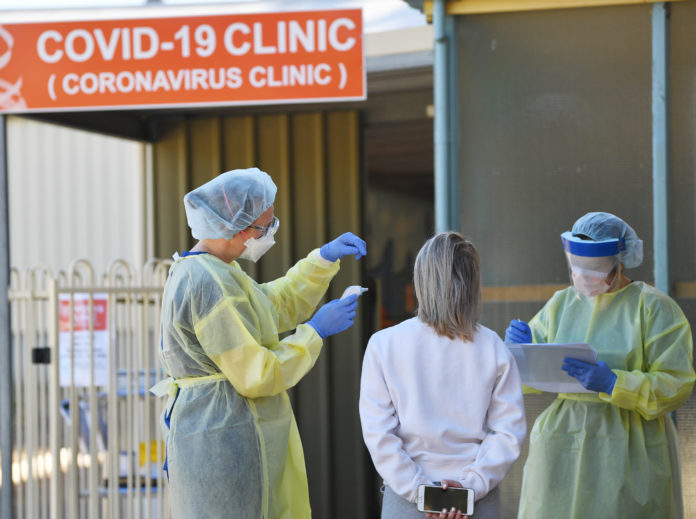Source: The Conversation (Au and NZ) – By C Raina MacIntyre, Professor of Global Biosecurity, NHMRC Principal Research Fellow, Head, Biosecurity Program, Kirby Institute, UNSW
Editor’s note: this is an edited version of a paper written in late March to outline the rationale for a short, sharp lockdown. The full version is below.
The COVID-19 pandemic is unprecedented and may have long lasting global effects.
Until a vaccine is available, we have four main measures at our disposal:
- identifying every case rapidly with extensive testing, and isolating cases.
- tracking and quarantine of contacts
- travel restrictions
- social distancing (including lockdown) to reduce contact (and therefore spread of infection) between people.
Unlike countries such as South Korea, Australia has taken a slow trickle approach of phased, targeted restrictions to reduce social contact along with continued restricted testing.
We are in a partial lockdown state now, but it has been gradual. Different restrictions have been added on a rolling basis over a few weeks now, with schools still open. This is more of a slow trickle approach than a short, sharp, instant lockdown.So far, Australia has not contained the epidemic as well as it could have, with a recent lapse in border control with the Ruby Princess cruise ship.
A silent epidemic may be growing, driven by mild or asymptomatic infections of people who did not meet our testing criteria.
A short, sharp lockdown for two to three incubation periods
The travel bans have been the most successful and strongest element of our approach. A phased approach of gradually increasing social distancing whilst keeping schools open will have some effect, but likely not enough.
It will leave us dealing with COVID-19 for much longer, with a slow trickle of new infections that keep feeding the epidemic. What’s needed is a short, sharp lockdown for two to three incubation periods (four to six weeks), combined with scaled up testing capacity and expanded testing criteria.
This strategy, similar to South Korea’s approach, would reduce the size of the epidemic substantially, spare the health system and give us a more manageable baseline from which to best protect Australia until a vaccine is available.
Epidemic growth is exponential, leaving little time for decision making. On March 1 we had 25 cases and now, nearly at the end of March we have over 4,700 cases.
While some of these are travel-imported cases, there is likely an as-yet undetected silent epidemic. In other words, there could be widespread community transmission of infections which restrictive testing and test kit shortages are preventing us from detecting.
We are concerned about the possibility of Australia losing control of the epidemic. We may well exceed health system capacity, increase the number of cases, experience health and economic losses, and a longer time to societal recovery.
A sharp lockdown needn’t last six to 12 months
While the curve has flattened since March 24, this is likely the impact of the travel bans implemented between March 5-10 on Iran, South Korea and Italy.
It is too early yet to see an impact of social distancing, and lapses like the Ruby Princess cruise ship incident, together with lack of testing for asymptomatic high-risk people, may allow transmission to continue in the community.
Modeling shows that the greatest impact will be gained by the most comprehsnive and immediate social distancing measures (such as lockdown), combined with enhanced testing and quarantine.
The argument that such measures need to be long-term (six to 12 months) is incorrect. China has demonstrated the feasibility of a short lockdown followed by phased lifting of restrictions.
A short, sharp, complete lockdown of four to six weeks will improve Australia’s control of the epidemic, reduce case numbers more rapidly and bring us to a more manageable baseline. From there, we can start to phase in lifting of restrictions safely. Economic recovery can begin.
The slow trickle approach, especially if schools remain open, may result in continued epidemic growth, potential failure of the health system, and a far longer road to recovery.
A more comprehensive lockdown buys time
A comprehensive lock-down also buys time to scale up required testing, capacity for rapid case identification and isolation, and for thorough tracking and quarantine of contacts.
Contact tracing could be aided by novel smart phone apps, deployed with great success in South Korea.
For lockdown to be successful in a short, sharp burst, it must be accompanied by scaled up testing. We must ensure every new case can be identified rapidly during the lockdown and in the follow-up phase, when restrictions are lifted.
We need greatly expanded testing including asymptomatic, high risk people (contacts, evacuees and people in enclosed outbreaks such as cruise ships, aged care facilities, prisons). And we must allow doctors to use their clinical judgement to order a test.
It’s time to scale up our capacity to produce test kits domestically, procure them from overseas or actively ask for help from other countries that have achieved testing at scale.
Without such an improvement in the public health response capacity, the coronavirus epidemic will almost certainly bounce back when even the current lockdown restrictions are lifted.
We have examples of countries which have failed and succeeded. We should allow these examples to guide our response.
– ref. Regaining control: the case for a short, sharp lockdown (rather than the slow trickle we’ve had so far) – https://theconversation.com/regaining-control-the-case-for-a-short-sharp-lockdown-rather-than-the-slow-trickle-weve-had-so-far-135203









